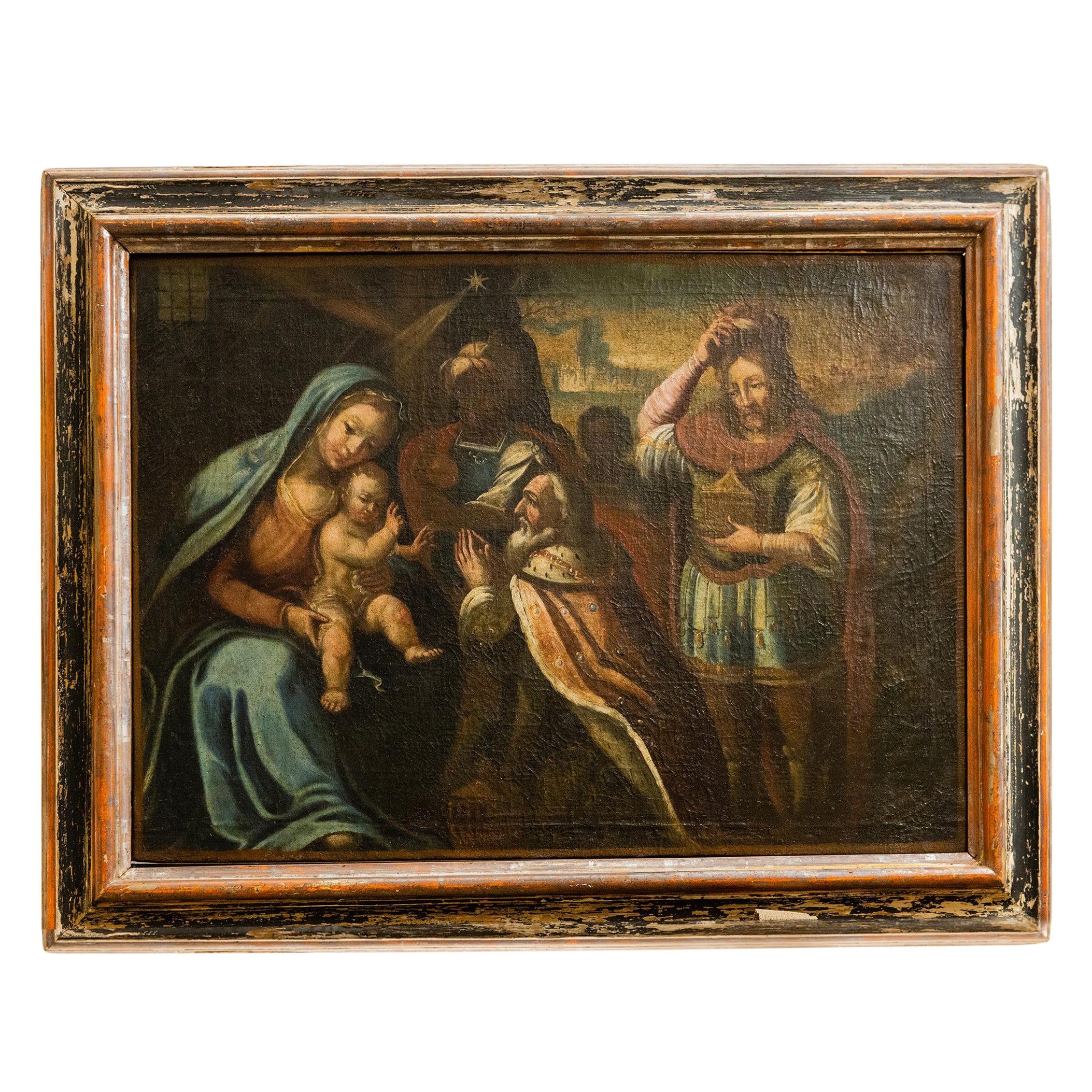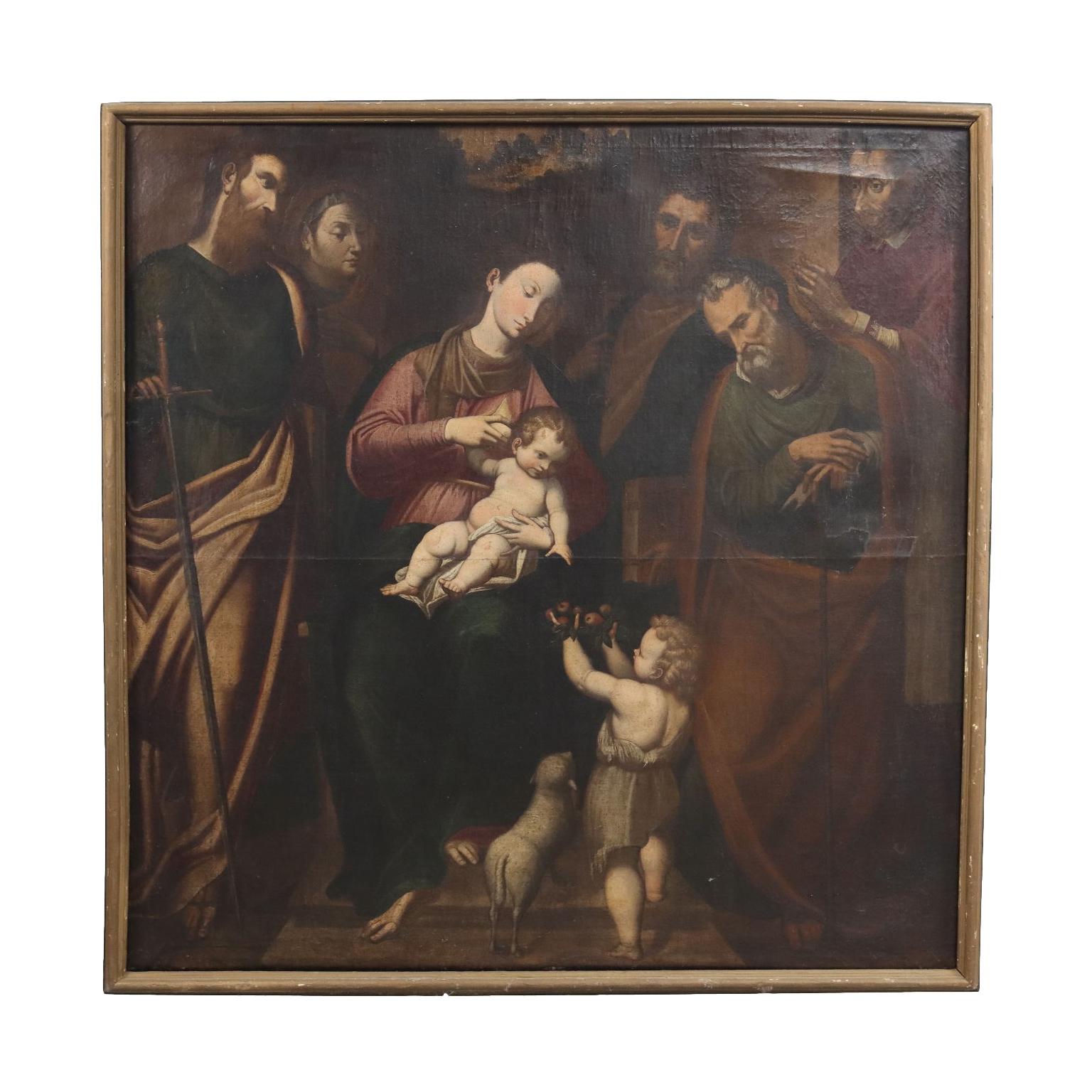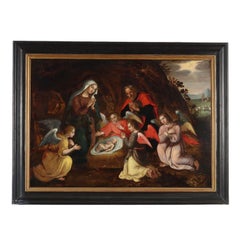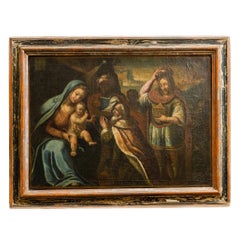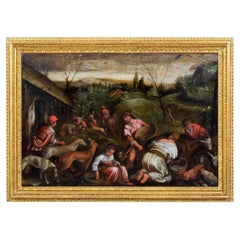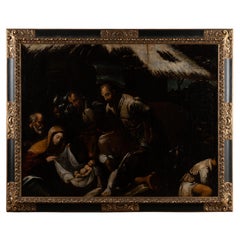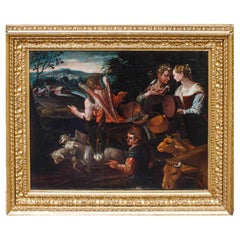Items Similar to Painting from the workshop of Francesco Bassano Nativity second half of the 500's
Want more images or videos?
Request additional images or videos from the seller
1 of 22
Painting from the workshop of Francesco Bassano Nativity second half of the 500's1500s
1500s
$18,785.31
£13,898.78
€15,600
CA$25,974.03
A$28,516.25
CHF 14,876.99
MX$345,086.27
NOK 186,459.93
SEK 175,694.28
DKK 118,778.84
About the Item
Oil on Canvas. Second half of the 16th century.
The painting comes from the historical family collection of Count Castracane, as is documented by the original handwritten paper receipt of Francesco Bassano (attached to the 'work)
The back of the frame also has an inventory cartouche at the top and the inscription "Castracane property" at the bottom.
The aforementioned Count Castracane belongs to the noble Castracani degli Altelminelli family of Fano, originally from Lucca.
Francesco Dal Ponte da Bassano, known as Il Giovane, worked for many years in the important workshop of his father Jacopo, known as Bassano il Vecchio, and then moved to Venice in 1578 where he set up his own atelier, though he continued to collaborate with Bassano's workshop, which had meanwhile been run by his brother Leandro after his father's death; towards the end of the 1580s, however, a crisis manifested itself in Francesco that was also reflected in his allegorical production: in a gradual rapprochement to the taste of his brother Leandro, the color lightened losing its strength, the forms expanded and simplified, and the composition became fragmentary.
The production of the Bassanesque family was most notable for sacred subjects, set, however, in rural settings, leading to call them biblical-pastoral.
In this painting, too, the Holy Family does not characterize the centrality of the scene, but is one of the two groups of very human figures occupying the right side of the scene, while on the left stands the group of shepherds with the animals of the countryside and the simple objects of daily life.
The rural context is also well defined by the surrounding objects, although the birth hut is replaced by an architectural structure with marble columns, but of a color that blends in with the other surrounding structures.
The only spiritual elements are the angel-lonely!-appearing to the shepherds for the announcement, relegated high up, small and barely noticeable; and the 'halo surrounding the head of the Baby Jesus, moreover depicted placidly asleep, unaware of what is going on around him and what awaits him.
Characteristic in the production of his father's Bassano workshop were the richness and vividness of color and luminous contrasts, which, however, became muted in Francesco, translating into more muted color choices and simplified forms, losing some of their strength.
This is also evident in this 'work, placed in the last years of the artist' s life, especially in the clothing of the characters; note in particular how Mary's robe is no longer red as per tradition, a color strongly symbolic of sorrow human, but it is the same rosy hue as the central pastor's tunic, as if to emphasize Our Lady's belonging to humble and simple humanity.
Moreover, Francesco Bassano in his last period, due to his state of health compromised by severe hypochondria (he died by suicide in 1592), had commissions for works that were only partly executed by him, but delegated, at least partially, to his assistants.
This depicts a 'work commissioned from him and from his workshop, as his autograph statement declares, but probably not made directly by the master, but rather by one of his collaborators.
The painting appears to have been restored and re-tinted.
It is presented in a late 18th- to early 19th-century antique wooden frame.
- Creation Year:1500s
- Dimensions:Height: 35.83 in (91 cm)Width: 43.31 in (110 cm)Depth: 0.79 in (2 cm)
- Medium:
- Circle Of:Francesco Bassano (1549 - 1592, Italian)
- Period:
- Condition:
- Gallery Location:Milan, IT
- Reference Number:1stDibs: LU680316208032
About the Seller
4.8
Vetted Professional Seller
Every seller passes strict standards for authenticity and reliability
Established in 2017
1stDibs seller since 2017
126 sales on 1stDibs
Typical response time: 3 hours
- ShippingRetrieving quote...Shipping from: Milan, Italy
- Return Policy
Authenticity Guarantee
In the unlikely event there’s an issue with an item’s authenticity, contact us within 1 year for a full refund. DetailsMoney-Back Guarantee
If your item is not as described, is damaged in transit, or does not arrive, contact us within 7 days for a full refund. Details24-Hour Cancellation
You have a 24-hour grace period in which to reconsider your purchase, with no questions asked.Vetted Professional Sellers
Our world-class sellers must adhere to strict standards for service and quality, maintaining the integrity of our listings.Price-Match Guarantee
If you find that a seller listed the same item for a lower price elsewhere, we’ll match it.Trusted Global Delivery
Our best-in-class carrier network provides specialized shipping options worldwide, including custom delivery.More From This Seller
View AllPainting Follower of Jacopo da Bassano Adoration of the Shepherds 17th century
Located in Milan, IT
Oil on Canvas.
Composition repeatedly replicated by followers and students of the Bassano school, particularly from a work by Jacopo Bassano (1515 -1592).
In the original scene, capt...
Category
17th Century Other Art Style Figurative Paintings
Materials
Oil
Painting Nativity of Jesus 18th century
Located in Milan, IT
Oil on oak panel. Flemish school of the XVII-XVIII century.
The sacred depiction proposes the moment of Jesus' birth in a cave, watched over and worshipped by Mary and Joseph togeth...
Category
18th Century Other Art Style Figurative Paintings
Materials
Oil
Adoration of the Shepherds, c. 1620.
Located in Milan, IT
Oil on Canvas. Venetian school of the 17th century.
Looking to the models popularized by Jacopo Bassano, the painting presents a scene rich in figures and contour elements typical of...
Category
17th Century Other Art Style Figurative Paintings
Materials
Oil
Painting Our Lady of St. Jerome, 17th-18th century
Located in Milan, IT
Oil on Canvas. Emilian school of the 17th-18th centuries.
This is an early copy of Correggio's famous panel painting entitled La Madonna di San Girolamo or Il Giorno (Our Lady of St....
Category
18th Century and Earlier Other Art Style Figurative Paintings
Materials
Oil
Religious Subject Oil on Canvas Italy XVII Century
Located in Milan, IT
Oil painting on canvas. Lombard school of the seventeenth century. The large scene presents in the center the seated Madonna proposing her breast to the Baby Jesus, who instead stretches out to try to pick a fruit from the basket that St. John gives him, standing under them; around, five figures of saints, recognizable by their iconographic attributes. From the left you have: St. Paul, holding the sword, St. Anna, lovingly watching over his daughter and grandson, St. Peter holding the keys to the Kingdom, St. Joseph with his stick and a carpenter's tool at his waist , and finally, last on the right, San Carlo Borromeo...
Category
17th Century Other Art Style Figurative Paintings
Materials
Oil
Religious Subject Oil on Canvas Italy XVII Century
Located in Milan, IT
Oil painting on canvas. Venetian school of the seventeenth century. Entirely in the foreground, this scene of a group of sacred figures, which presents the faces of Mary and the Chil...
Category
17th Century Other Art Style Figurative Paintings
Materials
Oil
You May Also Like
Antique Nativity Italian Painting
Located in Alessandria, Piemonte
Antique Nativity Christmas Italian oil painting on canvas, from first half 17th century. Anonymous painter (as usual at that time) and with an authe...
Category
Antique Early 17th Century Italian Archaistic Paintings
Materials
Canvas
17th Century, Italian painting Allegory of the Spring Follower of Jacopo Bassano
By Jacopo Bassano
Located in IT
Follower of Jacopo Da Ponte, called Jacopo Bassano (Bassano del Grappa, circa 1510 - Bassano del Grappa, 13 February 1592), 17th century
Allegory of the Spring
Measures: With frame: ...
Category
Antique Late 17th Century Italian Baroque Paintings
Materials
Canvas
17th Century Original Oil on Canvas Painting of The Adoration of the Magi, Spain
Located in Round Top, TX
Original oil on canvas painting of the adoration of the magi, with Mother Mary and infant Christ.
Framed over 5' wide x 4' tall, no signature/unknown artist.
Canvas has craquelure, o...
Category
Antique Early 17th Century Spanish Paintings
Materials
Canvas, Wood, Paint
Venetian school, Tobias and Sara in Nineveh, oil on canvas, 16th century
Located in Milan, IT
Venetian School, second half of the 16th century
Tobiah and Sarah led to Nineveh by the archangel Azariah
Oil on canvas, 48 x 56 cm - Framed, 58 x 72 cm
The present canvas, made w...
Category
Antique 16th Century Paintings
Materials
Canvas
Italian Early 17th Century Renaissance Baroque Oil Painting Entombment of Christ
Located in Portland, OR
An important & large Italian Baroque period oil painting on panel attributed to Daniele Crespi (1598-1630), "The Entombment of Christ", Milan circa 1620. See artist biography below.
...
Category
1620s Baroque Paintings
Materials
Oil, Panel
Oil on copper 800 Christ in the house of Martha with Mary and Lazarus
By A. Manzoni
Located in Villa Verucchio, Emilia-Romagna
Oil on copper 800 Christ in the house of Martha with Mary and Lazarus - A work of rare beauty
The 1800 oil on copper Christ in Martha's House with Mary and Lazarus is an extraordina...
Category
Antique Mid-19th Century Italian Renaissance Paintings
Materials
Copper

